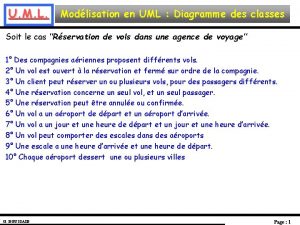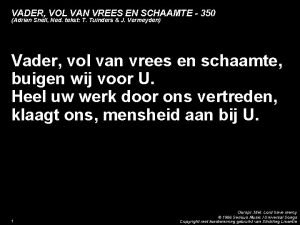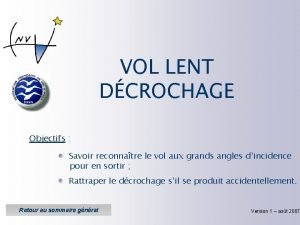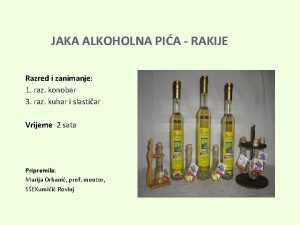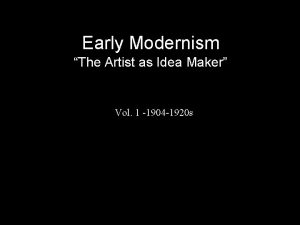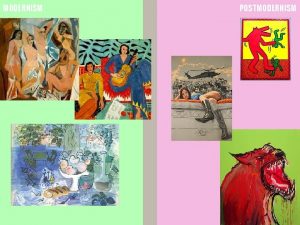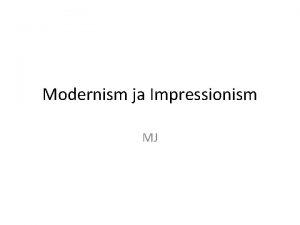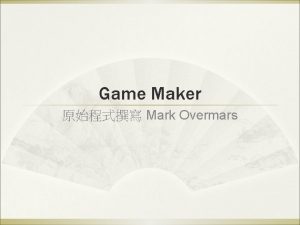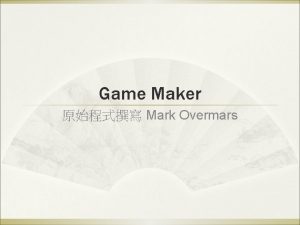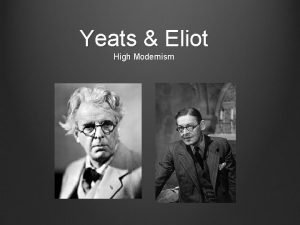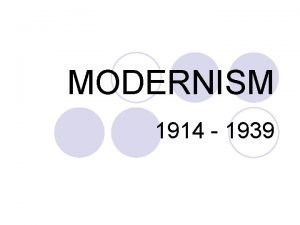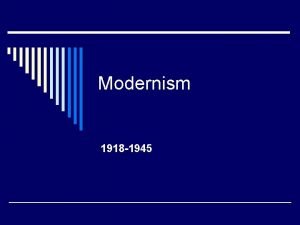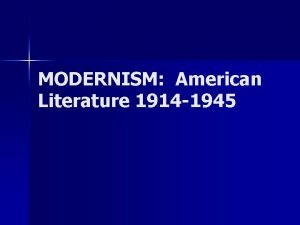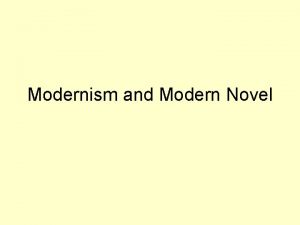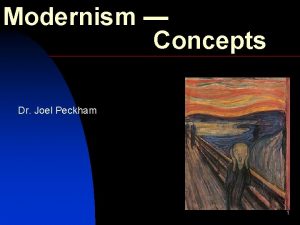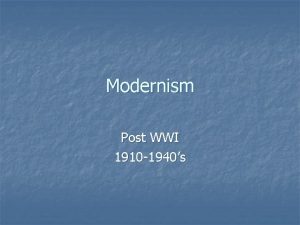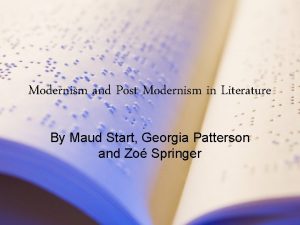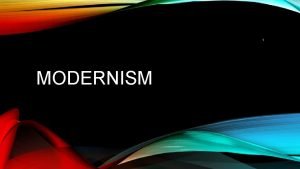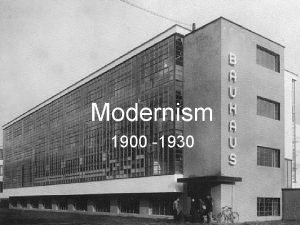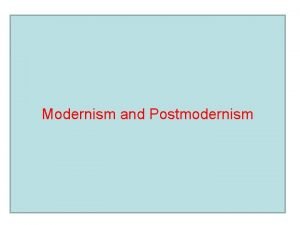Early Modernism The Artist as Idea Maker Vol































- Slides: 31

Early Modernism “The Artist as Idea Maker” Vol. 1 -1904 -1920 s

• A series of “isms” • Local traditions in art have given way to international trends • Three “isms” are most important and have branched off throughout the 20 th century- Expressionism, Abstraction, and Fantasy • Expressionism- the human community • Abstraction- the structure of reality • Fantasy- the individual human mind • Realism continues as a trend along with other movements throughout the 20 th century • Modernism allowed artists to assert their freedom to create in a new style and provide them with a mission to define the meaning of their times • Influenced by- the beginning of the atomic age -existentialism (Nietzsche)- “God is Dead” -the invention of psychoanalysis Freud-inner drives control human behavior Jung-collective unconscious -The Russian Revolution -The Great War (humanity’s inhumanity) -The Great Global Depression -the rise of the “Avant Garde”

Expressionsim-release of the artist’s inner vision -evoke feelings from the viewer Fauvism- very short-lived • full of violent color and bold distortion, brutal brushstrokes • Shocking to the critics and the public • Called “Fauves”- wild beasts • Artists wore the label with pride • Sense of liberation and experimentation held the group together • Color’s structural, expressive, and aesthetic capabilities

Henri Matisse, The Joy of Life, 1905 -06 • Flat planes of color, bold outlines come from Gauguin-also humanity in a state of nature- pagan scene like a bacchanal • “genius of omission”- radical simplification • The act of painting was joyous for him and his paintings show this

• Believed that color was the formal element most responsible for pictorial coherence • Color was not meant to imitate nature, but to express inner emotions Matisse, The Red Studio, 1911

• Fauvism with political connotations • Reminiscent of stained glass because Roualt was an apprentice • A figure of merciless authority clutching flowers Roualt, The Old King, 1916 -37

German Expressionism“Die Brucke” (The Bridge) • Color is important, but equal to that of distortion of images and violent brushstrokes • Movement centered in Dresden, Germany and led by Ernst Kirschner • Thought of themselves as bridging the old age of art with the new • Influenced by medieval craft guilds- lived and worked together equally • Focused on the detrimental effects of industrialization Kirschner, Self Portrait, 1915

• Most of Emile Nolde’s paintings were religious like Roualt • Slashing, violent brushstrokes for nonangry subject matter Nolde, Wildly Dancing Children, 1912

• Austrian painter related to the group • Like Van Gogh- saw himself as an inner visionary, a witness to inner truth • Tortured psyche influenced by Freud’s work Kokoschka, Self Portrait, 1913

Kathe Kollwitz • Worked almost exclusively in printmaking and drawing • Themes of inhumanity and injustice • The plight of workers and war victims • Pacifist- son died in WWI Kollwitz, The Survivors, 1923

• Der Blaue Reiter (The Blue Rider)- another German Expressionist movement • Produced feeling is visual form Kandinsky, Composition VII, 1913 • Complete abstraction- non-objective work-elimination of representation • Knew about music, literature, science (the atomic theory)- material objects have no structure or purpose • Orchestration of color, form, line, and space- blueprints for an enlightened and liberated society, emphasizing spirituality

• Armory Show of 1913 introduced America to Fauvism and German Expressionism • Started in NY and traveled to Chicago and Boston • Armory show contained over 1600 pieces of art- exposed American viewers and artists to work going on in Europe • Very controversial- NY Times called it “Pathological” • Alfred Steiglitz, a photographer, was pivotal in supporting American abstractionists • Marsden Hartley was an American living in Munich and was directly influenced by these European movements Hartley, Portrait of a German Officer, 1914

• Followed Matisse’s “genius of omission” • Disturbed the basic shape of the material as little as possible • Interested in primitive carvings and their formal simplicity and coherence Brancusi, Golden Bird, 1919

Moore, Reclining Figure, 1935 -36 • Henry Moore- simplicity of form continued • Also influenced by prehistoric- Monoliths • Classical motif that has been eroded

ABSTRACTION Picasso, Les Demoiselles D’Avignon, 1907 “I paint forms as I think them, not as I see them” • The process of analyzing and simplifying observed reality • First “rediscovered” by Cezanne • Picasso- staggering contributions to the history of art and the development of abstraction • Traditional artist in that he made careful studies of his work • Quest for innovation, insistence on challenging established views, constant experimentation • Found inspiration from African sculpture (due to widened colonialism) • Fractured shapes, jagged planes, illegible space-tension between 2 d and 3 d • Inconsistency of treatment of the women

Cubism • a radical turning point in the history of art • Dismissal of pictorial illusionism • Cezanne’s idea of the cylinder, sphere, and cone • New logic of design • Painting moved far beyond the depiction of reality- mirrored society’s fears of the uncertainty of a non-Newtonian world • Received its name after Matisse described a work by Braque as having been painted in “little cubes”

Analytical Cubism • Little contrast in color • Complex and systematic design • Faceted shapes, translucent divisions of space • Differing views of the same subject in the same work • Invented by Picasso and George Braque- at the same time, but not really in collaboration • Retains some sort of depth Picasso, Portrait of Vollard, 1910

Synthetic Cubism Braque, Gillet, 1914 New Space Concept- first since Masaccio • Invented by Braque and Picasso • Puts forms back together after breaking them apart • “Collage Cubism” after the French word for “paste -ups” • Foreign materials are pasted onto the designmakes the collage look like a real surface • Scraps are changed and painted on, giving them a double meaning • Both represent and present (be themselves) • Picture plane is in front of the surface

• Started to add color to Cubsim in the 1920 s • Renaissance perspective gone wrong • Jumble of flat shapes turn into a slight image • Dog beats to a rhythm Picasso, Three Musicians, 1921

• Cubism in sculpture • Fragmented, dissolved form • Split into many planes • Parallels with Braque and Picasso Lipchitz, Bather, 1917

Leger, The City, 1919 • Movement of Purism invented by architect Le Corbusier, the architect • Opposed Synthetic Cubism because it was out of touch with the machine age • Thought that design should come from the clean functional lines of machines • Ferdinand Leger- clean lines mixed with Cubist sensibility • Very precise and very large!! (7’X 9’)

Boccioni, Dynamism of a Cyclist, 1913 • FUTURISM • Cubism was adapted to stand for the dynamism of modern life- always moving and changing • Futurists rejected the past and exalted the beauty of the machine • Showed motion in a static image • 2 oth century energy • Many of the artists of the movement were killed in WWI- by the machines that they loved

DADA • Started as a reaction to the horrors of WWI and Nihilism • Began independently in Zurich and NY • French for “hobbyhorse” • Believed that reason and logic had been responsible for war • Only hope was anarchy, irrationality, and intuition • Pessimism and disgust of the artists helped them reject tradition • Arp pioneered the use of chance in artwork- releassed him from the role of artist • For Dadaists, the idea of chance comes from the unconsciousnessinfluenced by Freud Jean Arp, Collage Arranged According to the Laws of Chance, 1916 -17

• Duchamp was the central figure in NY Dada scene • Exhibited his first “readymade” sculptures- mass produced common products “selected” by the artist • Free from the opinions of the population- neither good or bad taste • Forces viewers to see the “artness” of objects Duchamp, Fountain, 1913

Surrealism • most Dada artists joined the Surrealist movement as well • Included many similar ideas -used Dada techniques to “release the unconscious” • Exploration of ways to express in art the world of dreams and the unconscious • Inspired by Freud and Jung- interested in the nature of dreams • In dreams, people moved beyond the constraints of society • To bring inner and outer reality together • Two forms of Surrealism; • Biomorphic (interested in life forms)- Miro • Naturalistic (recognizable scenes of nightmare or dream images)-Magritte, Dali

• Precursor to Surrealism • Disquieting sense of forboding and creepiness • As if another world exists beneath the one that is visible- influenced by Nietzsche who said “foreboding tha underneath this reality in which we live and have our being, another altogether different reality lies concealed” De Chirico, Melancholy and Mystery of a Street, 1914

• Interested in Collage and “decalcomania”- transferring oil paint from another surface • Used rubbings called “Frottage”joined fragmented images from newspapers and magazines to create a disjointed image Max Ernst, La Toilette de la Mariee, 1940

Salvidore Dali, Illuminated Pleasures, 1929 • The celebrity of the group • Dreamlike, disquieting combination of images- sexual in nature, convincingly real

• Joan Miro- organic forms that expand contract visually • Used automatism- planned accidents • Element of hallucination • Began paintings as collages so that he could move elements around at will • Combination of unconscious and conscious image-making Miro, Le Petit Rose, 1933

Klee, Golden Fish, 1922 • Used fantasy images to represent the non-visible world • Thought that humanity’s deeper nature could be found in primitive shapes and symbols • Studied nature and science, especially the processes of growth and change

Oppenheim, Luncheon in Fur, 1936 • Humor and eroticism of Surrealism translated into sculpture • Magical transformation of forms and textures to show the absurdness of everyday objects
 How to fade out audio in windows movie maker
How to fade out audio in windows movie maker Early cpr and early defibrillation can: *
Early cpr and early defibrillation can: * Tell more about the main idea
Tell more about the main idea Supporting ideas
Supporting ideas Contoh topik wacana
Contoh topik wacana Is the main idea the theme
Is the main idea the theme Whats a main idea
Whats a main idea Main idea and irrelevant idea
Main idea and irrelevant idea Exegetical idea vs homiletical idea
Exegetical idea vs homiletical idea Cse 477
Cse 477 Intensiewe vorm vir lelik
Intensiewe vorm vir lelik Alcohol minste calorieën
Alcohol minste calorieën Vol de nuit citation
Vol de nuit citation Force image
Force image Gevoelensthermometer
Gevoelensthermometer Vol plané
Vol plané Vprob
Vprob Swaption vol surface
Swaption vol surface Ap3456 vol 5
Ap3456 vol 5 Vca pbna
Vca pbna Vol chez le commissaire kivala
Vol chez le commissaire kivala N+ polysilicon gate
N+ polysilicon gate Interruption volontaire de vol
Interruption volontaire de vol Dsr cpwd 2019
Dsr cpwd 2019 Wanneer gebruik je een steekflens
Wanneer gebruik je een steekflens![[anthology] lq -little queen- vol. 40 [digital] [anthology] lq -little queen- vol. 40 [digital]](data:image/svg+xml,%3Csvg%20xmlns=%22http://www.w3.org/2000/svg%22%20viewBox=%220%200%20200%20200%22%3E%3C/svg%3E) [anthology] lq -little queen- vol. 40 [digital]
[anthology] lq -little queen- vol. 40 [digital] Diagramme de classe agence de voyage
Diagramme de classe agence de voyage Vader vol van vrees
Vader vol van vrees Sih-roh-sis
Sih-roh-sis Vol lent
Vol lent Ver
Ver Vinjak sastav
Vinjak sastav









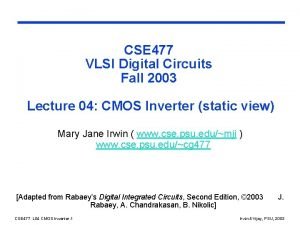
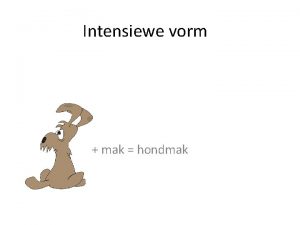
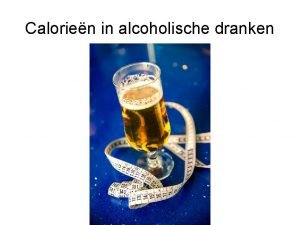

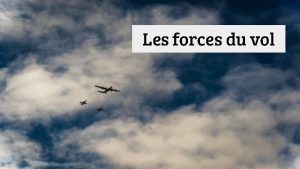
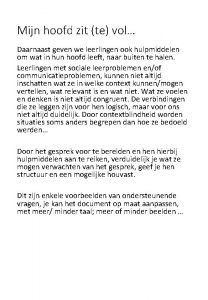
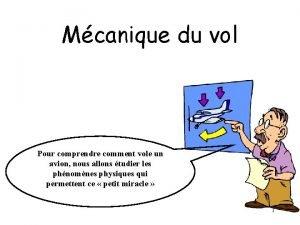

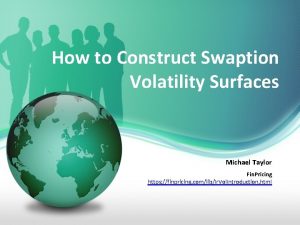


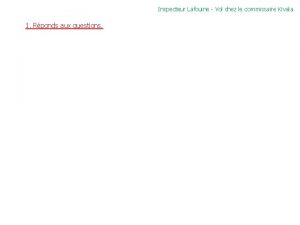
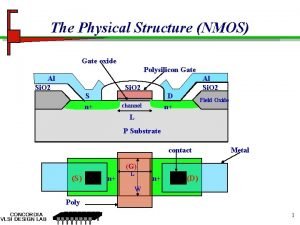



![[anthology] lq -little queen- vol. 40 [digital] [anthology] lq -little queen- vol. 40 [digital]](https://slidetodoc.com/wp-content/uploads/2020/12/3346623_ae8474c31416d58beb43272c3ea4efb2-300x225.jpg)
